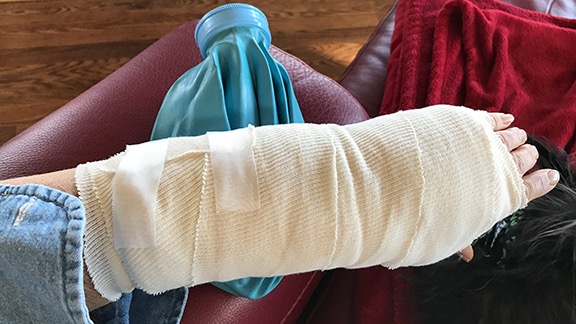An explanation of why there’s a honking huge splint on the end of my left arm.
I’ll make this short, if I can. I’m using dictation because I can’t type very fast with one hand. It’ll probably take me longer to edit this than to actually dictate it.
It all started back in August 2013. I had closed on the purchase of the property where I’d build my new home and was spending most afternoons at the property tearing out koshia, a type of invasive weed here. I left for the day, hot and tired and sweaty, and did some grocery shopping. I put the groceries in the back of my truck, which I never do. When I got back to my trailer, I climbed into the back of the truck, gathered up the groceries, and then attempted to vault off the tailgate up as I had done many times before. On that particular day, however, one of my feet got hung up on the tailgate’s spray-in bed liner and I didn’t make a clean jump. I landed on my left side and seriously sprained my left foot. You can read the details of that little accident in another blog post.

Here’s the lump at its least swollen state as I waited for surgery. When it was inflamed, it would triple in size and be quite painful. The knob below the swelling is a bone that’s supposed to be there. I have very thin wrists.
What I didn’t realize at the time is that I had also injured my left wrist. The problem manifested itself sometime later with some swelling in that wrist that never seemed to go away. Occasionally, after a hard day working at the house or in the yard, the swelling would increase and the rest will become very painful. On those days I had to turn to Ibuprofen and a wrist brace to keep the pain under control. Those little painful spells would often last several days, but the swelling would usually go down by the time I got to see a doctor about it. I did, however, get several tests done over the years, including x-rays, an MRI, and a cat scan.
This year, a bunch of little medical expenses added up to fill my deductible and I decided that it was time to fix this problem once and for all. The CAT scan identified what the doctor and I had suspected: there were tiny bone fragments loose in my wrist. He called these “floating bodies.” Apparently, when I moved my wrist under strain – for example, lifting something very heavy or twisting my wrist while I was holding something heavy —it caused these bodies to move, which would set off around of swelling and pain. The solution was to remove the floating bodies.

Although the X-ray and MRI were inconclusive, the cat scan clearly showed the floating bodies in my wrist, including this big one.
I scheduled the surgery for a time after my helicopter had gone into overhaul so I wouldn’t need to fly. That surgery was scheduled for yesterday.
A neighbor drove me to the hospital at 7 AM and the surgery began promptly at 8 AM. I was under general anesthesia so I don’t remember anything from the moment I got into the operating room until I was in recovery. I was very surprised, however, to find my left arm in what looked like a cast from my elbow down to my hand. It turned out to be a clamshell type splint that would hold my wrist immobile. The whole thing was wrapped up in bandages that I would have to keep clean and dry for at least the next week.

I was not expecting this.

My souvenir.
The doctor came by and told me the surgery had gone well, taking about an hour and 45 minutes. I was shown (and then given) a tiny bottle containing the bone fragments, wrapped in cartilage, that he had removed. There was no need so end the lumps in for biopsy because we already knew what they were.
I’m one of the unlucky people who gets no pain relief from standard painkillers like oxycodone or Percocet or codeine. I know — I’ve tried them all several times as prescribed for various painful ailments. Fortunately, my doctor had another alternative, something called Dilaudid (generic called hydromorphone). They gave me some of this while I was in recovery and although it took about 30 minutes to kick in, it worked like a charm. I was assured that if the pain continued or got worse at home, I could combine this new medication with ibuprofen, which normally works like a charm for me.
A friend drove me home and, after letting Penny out and back in, I climbed the stairs and made myself some lunch. That was pretty easy — I just reheated the leftover pasta from the day before. I took my lunch and something to drink over to the sofa, sat down and got comfortable, and then turned on the TV. I was asleep before I even got a chance to touch my food or turn on Roku. I woke up about an hour later, reheated my lunch, took a painkiller (because it was time), and settled back on the sofa to have my lunch and watch some TV. And that’s how I spent the rest of my day — watching more television that I normally do in a week. The third time Netflix asked if I was still watching, I decided to go to bed. It was about 8:30 PM.
Fortunately, the pain never really came back. It was just a dull ache when I took three ibuprofen before going to bed. I had the stronger painkillers nearby in case I needed them but I slept straight through until about 3:30 AM. Even then, I had no serious pain. I wasted time on Twitter and Facebook and even worked on a crossword puzzle on my iPad. Then I put it all aside and fell back to sleep — until 8 AM!
This morning, I feel remarkably good. Not tired and not in much pain. In fact, as I write this now at 10 AM, I still have not had any painkillers. I’m pretty surprised about that but also very happy. I do not like to rely on painkillers — or any medicine — for comfort.
So life goes on with the addition of a clunky bandaged splint on the end of my left arm. I have full use of my fingers but feel pain anytime I try to grip something or twist my wrist. So I’ll just try to take it easy with that hand. I had no trouble making coffee or breakfast this morning. Using the dictation built into my Mac computer or my iPhone is making it a lot easier to communicate in writing. So I guess I can say that this really isn’t too much of a hardship. It’s more of an inconvenience.
My next doctor’s appointment is on Monday when they’ll remove the splint and bandages and take a look at the incision site. With luck, everything will be okay and they’ll replace the splint with the same old wrist brace that I’ve been using before. (Note to self: run brace through laundry.) It’ll be nice to not have that lump in my wrist and the occasional painful swelling that went with it.
I should mention that I got this done now, while I’m still relatively young, because I didn’t want it to become an issue as I aged. I refer to this as “body maintenance.” It’s a lot easier to maintain a young body than an old one — just like a car.
